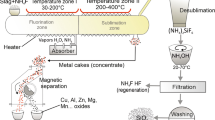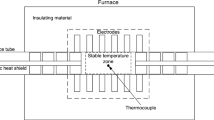A new direction in silicon carbide synthesis technology, which meets resource conservation requirements, is using large-tonnage artificial waste. Highly dispersed silicon carbide (SiC) powders were synthesized using microsilica as a silicon-based raw material. It is a finely dispersed, artificial waste from the production of metallurgical silicon and ferrosilicon and carbonaceous reducing agents containing natural gas, consisting of 94% of methane (CH4(g)) and fine wastes of oil coke (Cpc(s)). The latter is formed at the blending stage in silicon or ferroalloys production. Silicon carbide was synthesized in a resistance furnace at temperatures of 1600–1900°C. We have designed a special device to supply a part of the carbonaceous reducing agent in a gaseous state to the reaction zone of the furnace. Its design made it possible to realize the CH4 carbon and hydrogen dissociation on the feed route to the resistance furnace. Experiments were carried out by varying the proportion of methane in the composition of the total carbonaceous reducing agent (petroleum coke and methane) to determine the optimal synthesis conditions and achieve the maximum yield of SiC. While maintaining the total amount of carbonaceous reducing agent required by the stoichiometric ratio to reduce silicon with carbon, the proportion of CH4(g) increased from 0.15 to 0.60 of the total amount of carbon, and Cpc(s) decreased from 0.85 to 0.40, respectively. It is shown that lowering the petroleum coke proportion to 40% due to methane does not reduce the yield and quality of synthesized silicon carbide. Analysis of the chemical composition of the synthesized powders demonstrates the relatively high yield of silicon carbide, that is 69.2–72.8 wt.%, and the maximum value is reached at CH4(g) = 0.30 and Cc(s) = 0.70. The share of other impurities is free carbon (21.6–25.3 wt.%); silicon (0.8–1.3 wt.%) and impurities of metal oxides (1.8–3.4 wt.%). Electron microscopy found that the size of the synthesized particles ranges from several tens of nanometers to several hundred microns. The bulk of the particles has a dimension of fewer than 100 μm. Micro- and nanopowders of silicon carbide synthesized in this way belong to the 4H, 6H, and 3C polytypes confirmed by Raman spectroscopy and X-ray phase analysis. The proposed silicon carbide synthesis method will reduce production costs and open prospects for controlled regulation of this product's properties.








Similar content being viewed by others
References
P. Rai, Y.S. Kim, S.K. Kang, and Y.T. Yu, “Synthesis of nanosized silicon carbide through non-transferred arc thermal plasma,” Plasma Chem. Plasma Proc., 32, 211–218 (2012); https://doi.org/10.1007/s11090-012-9353-4.
J.H. Van Laar, I.J. Van Der Walt, H. Bissett, G.J. Puts, and P.L. Crouse, “Synthesis and deposition of silicon carbide nanopowders in a microwave-induced plasma operating at low to atmospheric pressures. Journal of the Southern African Institute of Mining and Metallurgy, 115, No. 10, 949–955 (2015).
V.V. Rudneva, “Features of carbide formation in a plasma-metallurgical reactor,” Bulletin of the mining and metallurgical section of the Russian Academy of Natural Sciences. Department of Metallurgy [in Russian], 16, 75–81 (2006).
T. Ebadzadeh and E. Marzban-Rad, “Microwave hybrid synthesis of silicon carbide nanopowders,” Mater. Character. 60, 69–72 (2009); https://doi.org/10.1016/j.matchar.2008.06.001.
B.M. Moshtaghioun, R. Poyato, F.L. Cumbrera, S. de Bernardi-Martin, A. Monshi, M.H. Abbasi, F. Karimzadeh, and A. Dominguez-Rodriguez, “Rapid carbothermic synthesis of silicon carbide nano powders by using microwave heating,” J. Europ. Ceram. Soc., 32, No. 8, 1787–1794 (2012). https://doi.org/10.1016/j.jeurceramsoc.2011.12.021.
V.A. Borodulya, L.M. Vinogradov, A.Zh. Grebenkov, and A.A. Mikhailov, “Synthesis of silicon carbide in an electrothermal reactor with a fluidized bed of carbon particles” [in Russian], Combus. Plasma Chem. 13, No. 2, 92–102 (2015).
X. Qiang, H. Li, Y. Zhang, S. Tian, and J. Wei, “Synthesis and Raman scattering of SiC nanowires decorated with SiC polycrystalline nanoparticles,” Mater. Lett., 107, 315–317 (2013); https://doi.org/10.1016/j.matlet.2013.06.055.
H. Chen, J. Jiang, and H. Zhao, “Synthesis of highly dispersed silicon carbide powders by a solvothermal-assisted sol–gel process,” Appl. Phys. A, 124, No. 470, 245–253 (2018). https://doi.org/10.1007/s00339-018-1885-x.
M.A. Hafiz, M. Sohor, M. Mustapha, and J.C. Kurnia, “Silicon carbide- from synthesis to application: a review,” MATEC Web of Conferences, 131, 04003 (2017); https://doi.org/10.1051/matecconf/201713104003.
H. Abderrazak and E. Hmida, “Silicon carbide: synthesis and properties,” in: Properties and Applications of Silicon Carbide, R. Gerhard (Ed.), April 4th, 381–388 (2011); https://doi.org/10.5772/15736.
A.S. Mukasyan, Y.Ch. Lin, A.S. Rogachev, and D.O. Moskovskikh, “Direct combustion synthesis of silicon carbide nanopowder from the elements,” J. Europ. Ceram. Soc., 96, No. 1, 111–117 (2013). https://doi.org/10.1111/jace.12107.
Y. Zhong, L.L. Shaw, M. Manjarres, and M.F. Zawrahy, “Synthesis of silicon carbide nanopowder using silica fume,” J. Am. Ceram. Soc. 93, No. 10, 3159–3167 (2010); https://doi.org/10.1111/j.1551-2916.2010.03867.x.
O.A. Polyakh, V.V. Rudneva, N.F. Yakushevich, G.V. Galevsky, and A.E. Anikin, “Application of technogenic wastes of metallurgical enterprises for the production of silicon carbide. News of higher educational institutions” [in Russian], Ferrous Metall., 57, No. 8, 5–12 (2014).
M.Sh. Kurbanov, B.M. Abdurakhmanov, and H.B. Ashurov, “Prospects for the production of silicon and solar energy products in the republic of Uzbekistan,” Appl. Solar Energy, 54, No. 2, 85–90 (2018); https://doi.org/10.3103/S0003701X1802007X.
M.Sh. Kurbanov, U.M. Nuraliev, S.S. Kurbanov, “The use of microsilica in the technology of obtaining silicon and ferrosilicon” [in Russian], Chemistry Chemical Technol., 1, 8–12 (2018).
V.M. Kevorkijan, M. Koman, and D. Kolar, “Low-temperature synthesis of sinterable SiC powders by carbothermic reduction of colloidal SiO2,” J. Mater. Sci., 27, 2705–2712 (1992); ID:200902071389892650.
R. Koc and S.V. Cattamanchi, “Synthesis of beta silicon carbide powders using carbon coated fumed silica,” J. Mater. Sci., 33, 2537–2549 (1998); https://doi.org/10.1023/A:1004392900267.
S.-H. Chen and C. Lin, “Effect of contact area on synthesis of silicon carbide through carbothermal reduction of silicon dioxide,” J. Mater. Sci. Lett., 16, 702–704 (1997).
J. Aguilar, J. Rodriguez, and M. Hinojosa, “Microwaves as an energy source for producing β-SiC,” J. Microwave Power Electromagnetic Energy, 36, No. 3, 169–177 (2016); https://doi.org/10.1080/08327823.2001.11688458.
A.L. Ortiz, F. Sanchez-Bajo, F.L. Cumbrera, and F. Guiberteau, “X-ray powder diffraction analysis of a silicon carbide-based ceramic,” Mater. Lett., 49, 137–145 (2001); https://doi.org/10.1016/S0167-577X(00)00358-X.
M. Ramachandran and R.G. Reddy, “Thermal plasma synthesis of SiC,” Adv. Manuf., 1, 50–61 (2013); https://doi.org/10.1007/s40436-013-0011-8.
E.N. Agaliamova, E.A. Belenkov, and V.A. Greshnyakov, “Structure of polymorphic varieties of silicon carbide” [in Russian], Bulletin of the Chelyabinsk State University. Physics, 10, No. 15(230), 15–24 (2011).
D.D. Avrov, A.O. Lebedev, and Yu.M. Tairov, “Polytype inclusions and polytype stability of silicon carbide crystals” [in Russian], Phys. Technol. Semiconductors, 50, No. 4, 501–508 (2016).
I.G. Aksyanov, M.E. Kompan, and I.V. Kulkova, “Raman scattering of light in mosaic films of silicon carbide” [in Russian], Sol. St. Phys., 52, No 9, 1724–1728 (2010).
L.M. Sorokin, N.V. Veselov, M.V. Shcheglov, A.E. Kalmykov, A.A. Sitnikova, N.A. Feoktistov, A.V. Osipov, and S.A Kukushkin, “Electron microscopic study of the SiC/Si(111) structure obtained by solid-phase epitaxy” [in Russian], Lett. ZhTF, 34, No. 22, 88–94 (2008).
M.E. Kompan, I.G. Aksyanov, I.V. Kulkova, S.A. Kukushkin, A.V. Osipov, and N.A. Feoktistov, “Luminescence spectra of hexagonal forms of silicon carbide in mosaic films obtained by solid-state epitaxy” [in Russian], Sol. St. Phys., 51, No. 12, 232–2330 (2009).
M. Bechelany, A. Brioude, D. Cornu, D. Cornu, G. Ferro, and P. Miele, “A Raman spectroscopy study of individual SiC nanowires,” Adv. Funct. Mater. 17, No. 6, 939–943 (2007). https://doi.org/10.1002/adfm.200600816.
Author information
Authors and Affiliations
Corresponding author
Additional information
Published in Poroshkova Metallurgiya, Vol. 61, Nos. 5–6 (545), pp. 50–62, 2022.
Rights and permissions
Springer Nature or its licensor (e.g. a society or other partner) holds exclusive rights to this article under a publishing agreement with the author(s) or other rightsholder(s); author self-archiving of the accepted manuscript version of this article is solely governed by the terms of such publishing agreement and applicable law.
About this article
Cite this article
Abdurakhmanov, B., Kurbanov, M., Nuraliev, U. et al. Application of Methane and Micro Silica for Silicon Carbide Synthesis. Powder Metall Met Ceram 61, 298–307 (2022). https://doi.org/10.1007/s11106-022-00317-6
Received:
Published:
Issue Date:
DOI: https://doi.org/10.1007/s11106-022-00317-6




